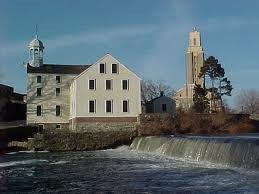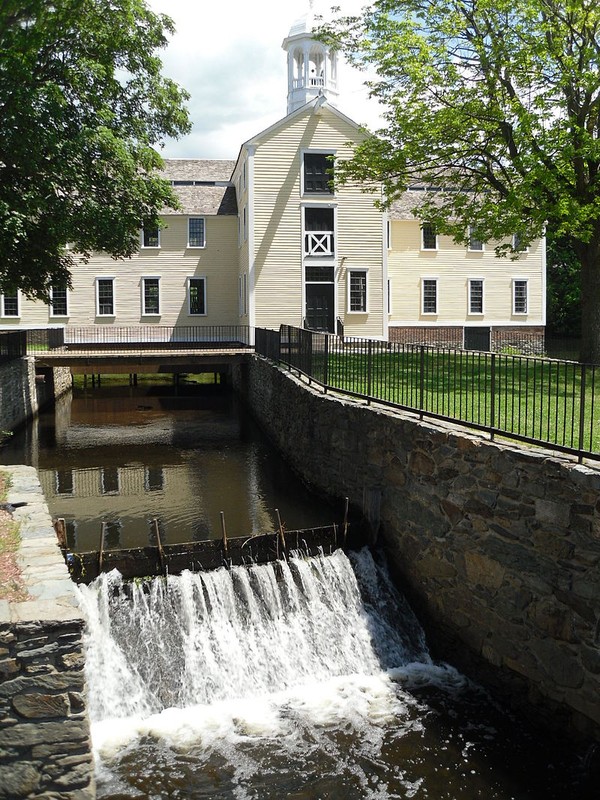Slater Mill Museum
Introduction
Text-to-speech Audio
Images
Slater Mill

Closer view of the mill

Backstory and Context
Text-to-speech Audio
Samuel Slater was a leading innovator during the American Industrial Revolution. He was born in England, where he apprenticed in a cotton manufacturing company. After years of training and hard work, Slater became a superintendent at the company. In Great Britain, it was illegal to share the secrets of the textile industry. It was also illegal for those who were employed in the industry, and therefore privy to those trade secrets, to leave the country. Samuel Slater covertly emigrated to the United States in 1789, with the plans and procedures for a textile factory ingrained in his memory.
The mill was built in 1793 and served produced cotton threading until 1829. It became a place that many families and children depended on for work and the founder, Samuel Slater hired all of the members of the family. He built tenements for them to live and a store which sold their basic necessities. He essentially created a small, family-oriented village for his workers. This system was referred to as the “Rhode Island System.”
In Slater’s factory, jobs were also broken down into simple tasks. Workers could focus on the one or two tasks that they were responsible for and then move the product down the line to the person responsible for the next task. This system was meant to assemble the products quickly and efficiently, and with less room for error. Also, some of the tasks were so simple that children as young as 4 years old could work in the factory with the rest of their families.
In addition to Slater Mill, there are two other historic sites located on the property: The Sylvanus Brown House and the Wilkinson Mill. The Sylvanus Brown House, the oldest building on the site, is typical of the mid-late eighteenth century. The house was built elsewhere in 1758 but moved closer to the mill in the 1960s. Most of the building is the original structure. Only the basement and the chimney were added later. The furnishings are not necessarily those that belonged to the original family, however, they are typical of the early nineteenth century. The home is also equipped with a loom, spinning wheel and other tools used to make cloth by hand. Inside homes like the Brown House, the women and children would clean and card the wool, spin the yarn, and weave cloth. The mills constructed around the same time industrialized this process, using machines to generate the same work.
The Wilkinson Mill was constructed in 1810, nearly twenty years after the Slater Mill was first built. The interesting thing about the Wilkinson Mill is that is shows what strides had been taken in the industrial process over just two decades. It is larger than the Slater Mill and has its own machine repair shop on the first floor. Its walls are made of stone rather than wood, to reduce the chance of fire (which was rampant in many factories).
Subsequent owners and renters used the building to make jewelry tools, coffin trimmings, and even for bike sales. In 1923 an organization arose with the goals of replenishing the mill to the shape it had been in in the late 1800s and the mill blossomed into a museum which was opened to the public in 1955. Several years later, it became the first property to be listed on the National Register of Historic Places. The museum is home to many workshop opportunities for the public use. The Slater Mill area is now considered a living history museum, educational center and community center. The museum contains acres of land on both sides of the river as well as a dam.
Sources
Samuel Slater: The American Factory System. Who Made America?. Accessed September 24, 2017. http://www.pbs.org/wgbh/theymadeamerica/whomade/slater_hi.html.
Slater Mill. Visit Rhode Island. Accessed September 24, 2017. https://www.visitrhodeisland.com/what-to-see/history-museums/1206/slater-mill/.
Slater Mill. Facebook. Accessed September 24, 2017. https://www.facebook.com/slater.mill/.
Slater Mill Historic Site. Woonsocket Connection. Accessed September 24, 2017. http://www.woonsocket.org/histsite.htm.
